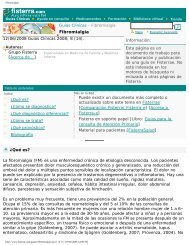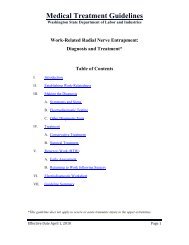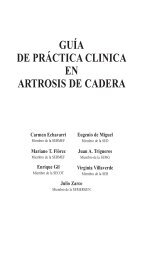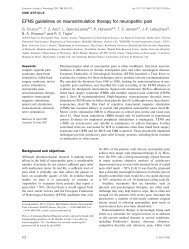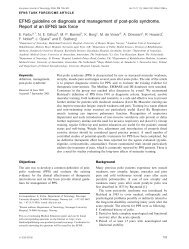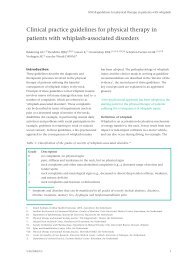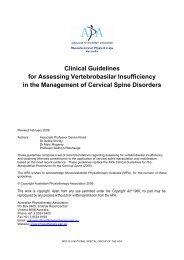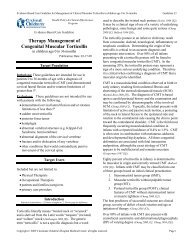GUIDELINES
GUIDELINES
GUIDELINES
You also want an ePaper? Increase the reach of your titles
YUMPU automatically turns print PDFs into web optimized ePapers that Google loves.
<strong>GUIDELINES</strong> FOR THE CLINICAL USE OF ELECTROPHYSICAL AGENTSTable 2. Specific testsModality Risk TestWax baths Thermal burns Thermal sensitivityHot packsInfrared radiationMicrowave diathermyShortwave diathermyUltrasound 10Cryotherapy Adverse reaction to ice Ice reaction testSensory stimulation (TENS)Motor stimulation (FES, NMES, FNS) Skin irritation 11 Sharp/blunt discriminationInterferential therapyElectrical burnsHigh voltage pulsed stimulationPainDirect currentUltrasoundUltraviolet Light UV burns Erythemal skin test (E1)Thermal sensitivityTest patient’s ability to discriminate hot from coldobjects at site to be treated. Typical items used areappropriately heated and cooled dry test tubes (filled)or metal spoons.Look for: inability to reliably discriminate hot fromcold. 12Ice reaction testTest by either performing an ice cube massage for aminimum of 30 seconds or apply an ice pack andexamine local response under the pack after 5 minutesand be aware of the possibility of latent effects.Look for: an excessive redness, an inflammatory wealor a systemic reaction, including increased bloodpressure or heart rate. 13Sharp/blunt discriminationThe area under the electrodes is tested using,typically, a new toothpick, a partially unfoldedpaperclip, or sharp pin. The skin must not be piercedand any test instrument only reused following thecleaning procedures outlined for non-criticaltreatment in Section 3 of this document.See table of contraindications and precautions and themodality specific information following it (Table 1).Erythemal skin test (E1)Always conduct an E1 skin test prior to commencingtreatment with UV or after lamp bulb/tube is changed.See Section 2, notes on specific EPAs, UV page, andconsult a standard textbook for further details.Recommended warningsThe therapist is responsible for ensuring the patienthas the information required to make an informeddecision and consent to treatment. This informationshould include the relative risks and benefits of theproposed treatment as well as what the patient shouldusually expect and their responsibilities regardingnotifying the physiotherapist of undesirable effects.The following warning statements are recommended,bearing in mind that each will need to be tailored toeach patient’s specific needs. 14The first is a general warning intended to covermodalities not specifically addressed.Note: record details of warnings given and documentinformed verbal consent. 15Look for: inability to reliably differentiate sharp fromblunt.10Therapeutic ultrasound: risks are typically thermal burns andpain.11Skin irritation, either an allergy or, more likely, electrolysiswill occur at electrode site with long duration monophasicpulses (direct current) and possibly with unbalanced biphasicpulses (time averaged current not zero).12Odia and Aigbogum 1988.13Knight 1995.14Delany 1996, p. 252.15Vines 1996, p. 246.5



